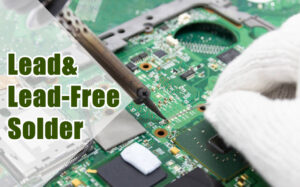A Guide to Lead and Lead-Free Solder in PCB Manufacturing
2022-09-21For years, PCB manufacturers have been facing industry challenges with the influx of new technologies, including miniaturization of PCBs, flexible printed circuits and the growing demand for green electronics. With the specified demand, PCBs are manufactured using non-toxic, environmentally friendly materials that reduce carbon emissions.
In this article we will discuss the differences between lead and lead-free solder and their applications.
What are lead and lead-free solder?
Leaded solder is an alloy made from lead and tin as the basic components. The use of lead in plumbing systems and water supply pipes connected to lead solder has been banned in the United States for many years. That is because of the harmful effects of lead on human health. Due to the use of lead in plumbing systems and the inhalation of dust and fumes produced by lead during soldering.
Since lead can affect people's health and is also harmful to the environment, leaded solder is gradually being phased out
The lead-free solders we mentioned are alternatives to the traditional 60/40 and 63/37 SnPb solders. In 2006, the EU issued the RoHS (Restriction of Hazardous Substances) regulation.
Today's lead-free solder formulations are based on the following common metals: copper, tin, silver, nickel, zinc, bismuth and antimony.
Comparison of leaded and lead-free solder pastes
The general soldering temperature depends on the alloy mixture and quality, the higher the tin content, the higher the melting point and the cost of the product. Leaded tin solder is much easier to use. Lead-free solder paste will melt at a higher temperature of approximately 422°F.
Leaded solder pastes, on the other hand, are harmful to humans and the environment, must be used only when permitted by regulatory agencies, and must be disposed of properly.
Factors to consider what kind of solder
Reducing or eliminating solder defects can effectively improve the reliability of circuit operation. In addition to this, other factors need to be considered.
-Temperature
-Vibration
-Tin whiskers
-Preheat time and capacity
-Operator skill level
Choosing the right formulation will play a role in improving the reliability of manufactured PCBs, and ideally, your partner should have extensive experience in RoHS material compliance.
Impact of different types of soldering
The choice of lead-free products for wave or through-hole soldering is based on the specific requirements or design parameters of the final assembly PCB. The choice of leaded and lead-free solder paste can also have an impact on the quality of the final product. The impact is minimized when the PCB manufacturer implements tightly controlled soldering parameters.
How to choose the right PCB manufacturer?
As the European and American markets gradually shift to lead-free soldering practices, many companies are following the EU's RoHS regulations, which limit the use of lead in electronics.
Your PCB manufacturer should help you with all the RoHS material compliance issues that affect your electronic PCBs. For more information on other electronics manufacturing regulations that may affect your designs, send us your request via email and one of our experts will contact you immediately!




